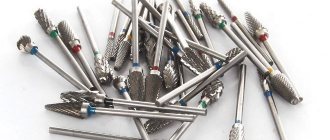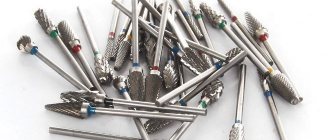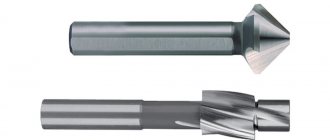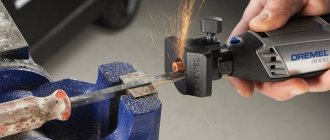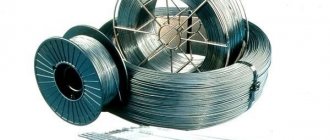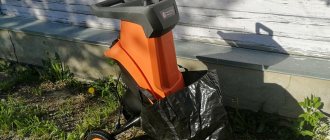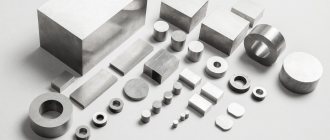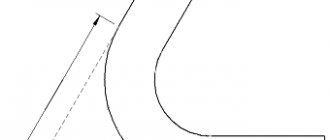Reamer refers to tools for finishing pre-drilled or countersunk holes. The operation allows obtaining geometric parameters, dimensional accuracy and high-class surface roughness.
Reamers are a more precise tool than twist drills or countersinks. Due to the precision of tool manufacturing and the small allowance removed during processing, inaccuracies and deviations after previous processing are eliminated.
Depending on the type of hole, processing conditions, and requirements for the quality of the finished surface, reamers of different types and designs are used.
Classification of scans
In metalworking, various types of reamers are used, divided according to the following characteristics:
Hole shape:
- Cylindrical reamers.
- Conical reamers for various types of cones.
- Step developments.
Hole Reaming Accuracy:
- Quality number for cylindrical tools.
- Hole processing level (roughing, intermediate, finishing) – for conical ones.
- Adjustable reamers – sliding, pivot or expanding.
Clamping method:
- Hand-held with square shank.
- Cylindrical shank (machine reamers).
- Conical machine.
- Machine mounted.
Reamers are also divided according to the number of cutting edges, material and shape of the grooves for chip removal (spiral or straight).
This is interesting: Manual wood router: which one is better to choose and how to work with it correctly
Conical reamers made of steel 9ХС
(steel P9, P18 or P6M5 is allowed)
| Ream designation 2372*1 | For the Moray cone | Dimensions, mm | Morse taper shank | ||||
| D | L | l | l0 | d | |||
| Morse taper with cylindrical shank according to GOST 11182 - 81 | |||||||
| 0132> | 0 | 9,045 | 95 | 64 | 48 | 6,2 | 1 |
| 0133 | 1 | 12,065 | 100 | 67 | 50 | 8 | |
| 0134 | 2 | 17,780 | 125 | 80 | 61 | 11 | 2 |
| 0135 | 3 | 23.825 | 150 | 97 | 76 | 16 | 3 |
| 0136 | 4 | 31,267 | 180 | 120 | 91 | 20 | |
| 0137 | 5 | 44,399 | 230 | 150 | 124 | 29 | 4 |
| 0138 | 6 | 63,348 | 310 | 205 | 172 | 35 | 5 |
| For shortened Morse taper according to GOST 11181 - 81 | |||||||
| — | 0a | 7,067 | 55 | 24 | 13 | 4,9 | — |
| 1a | 10,094 | 60 | 28 | 15 | 6,2 | ||
| 1c | 12,065 | 70 | 34 | 20 | 8 | ||
| 2a | 15,733 | 85 | 42 | 25 | 10 | ||
| 2v | 17,780 | 100 | 52 | 34 | 11 | ||
| Behind | 21,793 | 110 | 60 | 42 | 14,5 | ||
| Sv | 23,825 | 128 | 70 | 62 | 16 | ||
| 4v | 31,267 | 135 | 75 | 53 | 20 | ||
| 5v | 44,399 | BY | 90 | 65 | 29 | ||
| With a conical Morse taper shank according to GOST 10079 - 81 | |||||||
| 0131 | 0 | 9,045 | 140 | 64 | 48 | — | 1 |
| 0132 | 1 | 12,065 | 145 | 67 | 50 | ||
| 0133 | 2 | 17,780 | 175 | 80 | 61 | 2 | |
| 0134 | 3 | 23,825 | 215 | 97 | 76 | 3 | |
| 0135 | 4 | 31,267 | 240 | 120 | 91 | ||
| 0136 | 5 | 44,399 | 295 | 150 | 124 | 4 | |
| 0137 | 6 | 63,348 | 385 | 205 | 172 | 6 | |
General designation of sweeps.
*1. Examples of sweep designations:
with a cylindrical Morse taper shank 3 Morse reamer 3 GOST72-0135
for shortened Morse taper 3a Morse scan 3a GOST 11181 - 81
with tapered shank Morse reamer 3 GOST 10079 - 81 2373-0134
Purpose and principle of operation
A reamer is used to ream holes - the process of finishing them mechanically after drilling or countersinking.
The use of this tool allows you to achieve a high class of roughness of the hole walls and the accuracy of their geometry.
Depending on the type and characteristics, it is used to perform specific technological tasks, including calibrating holes and cleaning them from burrs at the final stage of part processing.
A special feature of this tool is a large number of teeth (usually from 6 to 16), which allows you to remove a small allowance, thereby adjusting the actual dimensions of the hole to the required ones with high accuracy.
As for the shape of the holes, you can work with a reamer either along the cylinder or adjust the cones for various tasks, for example, for installing tapered pins.
The teeth of the tool remove a layer of material by fractions of a millimeter; processing occurs through its rotation, as well as simultaneous longitudinal feed.
Design varieties
Based on their design features, devices can be divided into three classes:
- Solid;
- Mountable;
- Customizable (adjustable).
One-piece models are a completely cast sample with a shank and are made of alloy carbon steel. In other cases, they can be cast from high-speed steel. These models are the most common and have an affordable price.
Slide-on reamers look like tubes with an internal hole. Their outer diameter can reach 300 millimeters. They are most often used in machining because their shank is specially designed to be fixed in a machine chuck. They are considered quite universal models, because... their shank can be machined to suit various machine variations.
Adjustable (customizable) are made in diameter up to 50 millimeters and this indicator can be changed by setting. These samples can replace several types of classic scans, however, the adjustable range is quite small. For the smallest models, this figure reaches fractions of a millimeter. However, the main advantage of these variations is not only the ability to adjust the diameter, but also their long service life. The bottom line is that classic reamers can wear out over time, but custom reamers can always be adjusted to the desired diameter. As the sharpening of the blades wears off, only the maximum thickness of the processed hole decreases, which can always be expanded.
Deployment Processing Features
When drilling, there is a possibility that the dimensions will differ significantly from those that needed to be obtained. This is due to the fact that at the time of machining there is high pressure on the workpiece, the material and the cutting part itself can heat up and deform. This is why many people decide to use a reamer to achieve high quality holes.
The features of the processing carried out include the following points:
- You can achieve processing accuracy that will correspond to a quality in the range from 6-9. Such precise holes are required when obtaining critical products.
- The roughness index can be in the range from 0.32 to 1.25 microns.
- Considering the features of devices intended for deployment, we note that there are about 4-14 cutting edges on the surface. Due to this, the quality of processing and dimensional accuracy are significantly improved. It is the large number of cutting edges that determines that no deformation of the tool or workpiece occurs during cutting.
- When processing a hole, the product rotates around its axis, and it is also given a reciprocating motion. This ensures the removal of edges that could reduce the quality of the surface.
In general, we can say that the drill in use does not differ significantly from the product in question. In both cases there is rotation and reciprocating motion. However, in the case of deployment, the processing carried out is finishing and involves a high rotation speed.
Homemade devices: is it worth using?
Due to the fact that the device in question is designed to provide high accuracy of the final result, its homemade versions are extremely rare. This circumstance also involves the use of special equipment for its manufacture, since it will be necessary to process different types of steel, which, if chosen incorrectly, will reduce reliability and efficiency. However, the easiest way at home is to make a conical tool for expanding grooves in soft metals. Thus, professionals advise not to tempt fate and use exclusively factory-made devices.
Basic techniques for working with sweeps
The drill for preparing the hole is selected to match the diameters of the metal reamers. There must be a small allowance - the drill should be 0.2 - 0.3 mm smaller for rough reaming, and no more than 0.05 - 0.1 mm for finishing. Allowance values greater than those specified can cause rapid wear of the intake part of the reamer, deteriorating the accuracy of the result and the quality of the surface.
For manual sweep:
- The reamer is attached to the collar and lubricated.
- The intake part must fit in such a way that the axes of the reamer and the hole completely coincide.
- To check the position of the reamer, you can use a square in two planes located perpendicular to each other.
- Start rotating to the right with slight pressure from above.
- Rotate smoothly, at low speed, without jerking. Do not speed up the rotation even at a light speed.
- Reverse rotation is unacceptable, as it may cause breakage of the cutting edges and burrs on the surface of the hole. Reaming is carried out in one pass on one side.
Tips for machine scanning:
- The reamer is attached in the same way as a drill. The process itself is similar to drilling and it is advisable to perform it without changing the installation of the part, immediately after preparing the hole.
- Often the reamer is mounted in oscillating holders, which allows the tool to self-center along the axis of the hole.
- It is advisable to use automatic feed; the cutting speed should be 2-3 times lower than when drilling.
- A significant amount of lubricant must be used.
- The lower the number of revolutions and feed speed, the higher the quality of the hole and tool life.
This is interesting: Fuel pellets (granules) - varieties, features, production
Manufacturers
At the moment there are not many prominent brands on the market that are worthy of mention. Among foreign companies, I would like to specifically mention Bahco and Licota, and Rock FORCE also deserves attention.
But our domestic manufacturer often sets more reasonable prices with good quality. TECHMASH or Russian Instrument, as well as AvtoDelo - these companies will be able to give serious competition to foreign companies. Contact us and we will select the equipment you need. Contact us by contact number for consultation.
Well, our review has come to an end. Now you know exactly what sweeps are used for. And you can easily choose the most effective and suitable products for yourself.
Description of design
In most designs, the reamer looks like an oblong pin. Its working part is cylindrical or conical, with longitudinally running cutting edges for removing metal, and grooves that form the structure of the tooth. The opposite part is used to secure the tool and transmit the cutting motion. The end of the shank has a square or tapered shank. A transition neck connects the working part and the shank.
Floating chuck for fastening reamers
The tool is mounted with a shank in the conical chuck of a metal-cutting machine, and a wrench is put on the square for manual processing.
The cutting edges of the working part are divided into several zones. The first is the fence part, it is conical in shape and short in length. Behind it there is a guide and calibrating section, at the end there is a reverse cone to prevent jamming.
The teeth are straight, helical and spiral. Only in some cases the cutting edges follow the helix. Their use is justified when cutting intermittent holes.
The form-building structure of the tool is clearly visible in cross section.
In cross section, the structure of the working area consists of:
- Cutting edges;
- Ribbons;
- The front cutting surface along which chips flow;
- Posterior surface and back of the head.
The tooth shape is different in the sampling and calibrating parts. On the intake section it is sharpened, and on the calibrating section it has a ribbon for smoothing the walls.
A reamer, like a countersink, consists of a working part, a neck and a shank
Existing forms
Due to the fact that the creation of precise holes is an integral part of production in various branches of machine tool and mechanical engineering, reamers come in many shapes and sizes. Based on their form, they can be divided into three groups:
- In the form of cylinders;
- In the form of cones;
- Multi-stage.
The first are the most common and are used to create traditional round holes. Their grooves have a straight or helical shape with special recesses for removing chips.
The latter have a cone shape and a cut off top. With their help it is possible to work on both classic and conical holes. Either way, the end result is the creation of a tapered hole. Excess chips are removed through both straight and helical grooves.
Stepped models are considered the rarest due to their versatility, since they are capable of aligning holes in sheets of metal. Structurally, they have a conical shape, but their bevel occurs in steps, and not smoothly. This design is particularly whimsical, but if it is used competently and professionally for processing sheet metal (only a few millimeters thick), then it can last a long time.
Depending on how qualitatively the future hole should differ from the existing one, the device should be used in one or more approaches. As a rule, a professional turner can limit himself to 3 approaches - roughing and roughing, intermediate and finishing. The first pass consists of a rough trim, after which the second pass removes burrs and any protrusions that have formed. The final step is a finishing reamer, with which the insides of the groove become particularly smooth.
Differences from drills
A drill, by definition, is a tool that is designed to create initial holes. Reamers are not suitable for this, but are needed only for finishing already created holes to the required dimensions.
IMPORTANT! In principle, visually both objects are similar to each other, but are not interchangeable. Thus, each of them should be used only for its specific task.
Differences in area of use
The described tool can be used both manually and mechanically. For manual samples, the diameter can be set within the range of 3-50 millimeters. Its tail element has a special recess for a square-shaped profile for easy fixation in the collar. The smaller the diameter of the reamer, the easier it is to work with it, because the friction area will decrease. When working by hand, it is necessary to start screwing properly, as there is a risk that the entrance to the hole may become deformed and take on an oval shape.
Machine-type reamers are installed on machines. Their diameter is significantly thick, so they are convenient to fix in turret, lathe and drilling machines. Their shape can be either cylindrical or conical.
How to Use Manual, Mechanical, Adjustable, and Spread Reamers
Let's look at the features of the tools.
How to use manual reamers
Manual metal reamers are manufactured in accordance with GOST 7722-77. Size range: 3–58 mm. Steps may vary.
When choosing manual metal reamers, craftsmen pay attention to the following parameters.
- Tool dimensions.
- Number of teeth.
- Uniformity of their distribution.
- Type of cutting part.
- Groove profile.
- Type of clamping part.
Reaming holes with a hand tool is done using a wrench. To secure it, there is a special groove at the end of the shank. Usually everything happens this way.
- Marking and marking are carried out.
- The hole is drilled.
- The reamer is secured in the driver, lubricated and inserted into the hole.
- To deploy it, the tool is rotated clockwise.
- The final stage is checking the hole parameters using a gauge.
Image #2: Reaming holes by hand
Let's talk about the important features.
- Manual reamers are very effective. The cutting teeth have sharp edges along their entire length.
- The diameters of the front surfaces of the working parts are reduced. Tools easily fit into pre-prepared holes of the required diameters.
- By increasing the number of cutting edges, the quality of the machined holes increases.
- The holes must be drilled out smoothly. Don't speed up even when moving lightly. Avoid jerking.
- The reamer cannot be rotated in the opposite direction. This leads to breakage of the cutting edges, as well as the appearance of scoring in the holes.
How to use machine reamers
Machine reamers are secured in chucks of lathes, drilling and milling machines. These tools have short working parts with steep leading edge angles (up to 45°). Machine deployment significantly improves productivity.
To machine a hole, you need to secure the reamer, add coolant and align the axes. Next, you need to set the desired rotation speed and start the equipment.
Machine reamers and their application have the following features.
- Tools have a large number of cutting edges. The quality of the resulting holes is at a very high level.
- Machine reaming requires spindle runout compensation. To eliminate this negative factor, hinged mandrels are used.
- Processing is carried out at high speeds. Machine reamers have increased wear resistance.
- The sweep is positioned precisely. Due to this, the tool smoothly enters the hole. The same pressure is applied to all teeth. This greatly improves accuracy and minimizes runout.
- The speed during reaming is less than when drilling, approximately 2–3 times. Tools do not overheat.
- Machine reaming requires the use of significant quantities of cutting fluid.
Photo #6: Machine deployment
How to use adjustable reamers
Adjustable reamers allow you to change the outer diameters of the cutting parts to suit specific hole diameters. This is especially useful when machining holes with fractional diameters.
Using small adjustable reamers, you can change the diameter within a range of up to 1 mm. Larger instruments have wider adjustment ranges. Diameters can be varied up to 3 mm.
Photo No. 7: adjustable metal reamer
Adjustable reamers are used in the same way as regular ones. The main difference is that tools of this type are equipped with replaceable knives, which are securely fixed by wedge inserts with linings. The adjustment is made using a locknut. When tightened, the processing diameter increases, and when loosened, it decreases. After adjustment, the diameter is checked using a caliper and a micrometer.
How to use expansion reamers
They are also called sliding ones.
Photo No. 8: metal expansion reamer
Inside such a reamer there is a ball and a screw. When it is twisted, the ball moves and pushes the edges of the tool apart. The diameter increases slightly. The use of expanding reamers makes it possible to increase processing diameters by 0.15–0.5 mm.
It is not recommended to use too much force when tightening the screws. The reamer body may crack.
GOST
There are several standards that regulate product quality. Thus, GOST 29240-91 is responsible for the standard variety, as well as size ranges. And if you understand models that have an allowance, then you will have to be guided by a completely different regulatory document. Or more precisely - GOST 11173-76. A very common procedure at home. When the source of supply becomes not a machine, but an ordinary hand-held device. And in this case, we need to pay attention to GOST 7722-77. But another document, numbered 1672-80, already regulates the standards in one-piece machine-type models. That is, just the factory settings.
Practical guidelines for drilling holes
It is better to divide the boring operation into several stages: roughing and finishing. The allowance is divided accordingly and tools of two categories are used:
Reaming holes - process
- The allowance for a rough pass is 0.1-0.15 mm, for a finishing pass – 0.1-0.05 mm.
- To increase processing efficiency, the adjacent end surface is ground. The procedure allows you to use each tooth of the reamer during processing.
- For cast iron parts, the end of the hole must be machined so that the tool does not become dull.
- A clean deployment operation requires smooth execution. The smaller the feed, the better the quality of the surface. The speed is set to low.
- The metal-cutting tool is removed from the hole smoothly, avoiding rotation in the opposite direction, which can disturb the surface.
- The use of coolant will help improve the durability of the working element and the quality of processing. When deploying steel parts, coolant with the addition of oil is supplied to the cutting zone.
- Cast iron is processed using kerosene or compressed air.
To control the accuracy of finished holes, smooth plug gauges and bore gauges are used.
Reamers fall into the category of precision and expensive instruments. Requires compliance with operating and storage conditions in special wooden cells.
Related video: Adjustable sweep
Instead of an epilogue
Based on the market analysis, it was established that the majority of presented reaming products are intended for manual work. What’s gratifying is that Russian manufacturers are leading in most segments, offering above-average quality at fairly reasonable prices. At the same time, machine samples are more represented by foreign manufacturers, but they are not in high demand due to their narrow specialization. Thus, selecting high-quality tools for development work does not present any particular problems. At the same time, the order does not have to be placed only in retail chains - high-quality samples can also be purchased through online platforms, while significantly saving on the price without including delivery costs.
What holes are machined with reamers?
The master can process cylindrical or conical holes with a cutting tool. Cylindrical armholes are created by reamers with the main part in the shape of a cylinder. Use hand or machine tools.
Conical holes are made with conical-shaped reamers, but not immediately. Typically, the process is divided into three stages: roughing, intermediate and finishing. The finished conical hole is checked using a cutting product with a conical gauge.
What you need to know
Even when I work manually, there is an opportunity to insure myself against a lost axle. It would seem that without a machine it would still be impossible to clearly fix the center and maintain it. But there is a way - you just need to purchase a type of equipment with a coaxial shaft. And then the human factor will be leveled out. True, the model does not provide other advantages of machine processing, please keep this point in mind.
Important rules and features of hole deployment
- For rough reaming the allowance is 0.1–0.15 mm, for finishing reaming it is 0.1–0.05 mm.
- The final deployment is carried out smoothly. Reducing the feed improves the quality of processing. When finishing deployment, set low speed.
- Coolant must be used when reaming holes. When processing cast iron parts, kerosene or compressed air is used.
- To increase efficiency, the adjacent end surfaces of the parts are ground. In this case, all cutting edges of the tools are used during reaming.
- Reamers must be removed smoothly from the machined holes. Reverse rotation is not permitted.
- To control accuracy, it is recommended to use bore gauges and plug gauges.
The difference between countersinking and related operations
Countersinking is similar to reaming holes; the cutting edges of the tool remove excess material from the stenoctium, reduce roughness and increase the diameter. This is a semi-finish operation, which means it is followed by another processing step. Deployment is the final procedure. During countersinking, defects in drilling, stamping and casting are eliminated. In the process, you can slightly adjust the binding to achieve better alignment for the future connection. Accuracy can be increased to 5, and sometimes even to 4th class.
When setting the cutting mode, you need to remember that the thickness of the metal removed during countersinking is equal to half the allowance for a given hole diameter. Compared to drilling, the feed can be made 1.5-2 times larger, but the speed can remain the same. Specific cutting parameters are calculated using formulas given in the regulatory literature.
Since a countersink has greater rigidity compared to a drill, due to the increased number of sharp protrusions, the accuracy of the direction of movement increases, as well as the quality of processing, smoothness and cleanliness of the surface. For comparison, drilling gives a roughness of 20 microns and grades 11–12, countersinking gives a roughness of 2.5 microns, grades 9–11, and reaming gives a roughness of 0.25-1.25 microns and grades 6–9. Quality is the precision of manufacturing a part; as its value increases, tolerances increase and accuracy decreases. If the technological process for processing a product requires both countersinking and reaming, then they are performed in one installation and alignment of the workpiece on the machine.
This type of machining creates recesses to accommodate fasteners flush with the surface of the part. In addition to chamfering, a countersink is used to cut conical-shaped recesses. Another purpose will be to clean and process recesses before installing fasteners; this is done using flat or end countersinks, also called counterbores, which is more correct.
The most widely used on the market are conical countersinks with working angles of 90 and 120º, which create recesses to hide the heads of bolts and screws. In the metalworking industry, countersinks with a flat tip are also used, used for cleaning recesses for fasteners. Countersinks are installed in the same machines as other tools for processing holes for fasteners.
